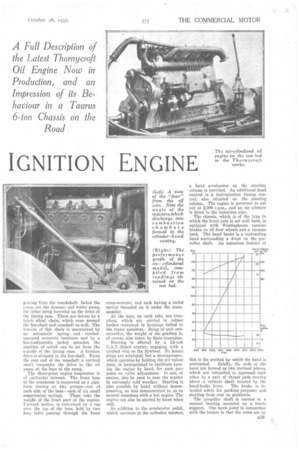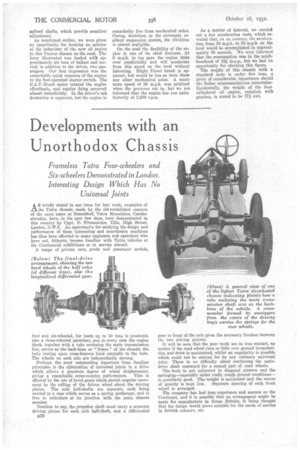N
Page 44

Page 45

Page 46

If you've noticed an error in this article please click here to report it so we can fix it.
EW British-built
COMPRESSION IGNITION ENGINE
DURING the past year John I. Thornycroft and Co., Ltd., Basingstoke, has been carrying out experiments in connection with the development of a new type of oil engine, constructionally entirely different from the original Thornycroft oil engine, which was little more than an adaptation of the Thornycroft petrol engine, and has evolved a design which has given gratifying results. We are now able to announce that the newly developed type is out of the experimental stage and is actually in production.
The latest Thornycroft oil engine is available in two forms, as six-cylindered and four-cylindered models. As the " six " closely resembles the "four," we will confine our description to the lat ter, the behaviour of which in a 6-ton chassis of the Taurus class we were able recently to test. This chassis, incidentally, which is a comparatively recent development, possesses certain interesting features which also deserve to be briefly mentioned.
The engine, designated type-CINC4, is rated (under R.A.C. formula) at 36.1 h.p. and develops 92 b.h.p. Its dimensions are 41 ins. (1211$ mm.) bore and 6i ins. (165 mm.) stroke, that is 461 cubic ins. (7,550 c.c.) capacity.
Bla The cylinders in both the " four " and the " six " arein a single casting, and have cast-iron dry liners ; the detachable head is also in one piece. A deep-section casting of Elektron, heavily ribbed and extending below the centre line of the crankshaft, forms the crankcase, and long bolts pass right through securing the block and the main-bearing caps. Five white-metal bearings, of 3k-in. diameter, carry the balanced crankshaft. Flat-topped aluminium pistons, having five compression rings and one scraper ring, are used, and the connecting rods are of steel.
The vertical air and exhaust valves are situated in the head. They are push-rod operated, through rockers, from a camshaft running in a tunnel formed in the cylinder casting. Injection is effected by a C.A.V.-Bosch fuel pump and injection valves. The latter discharge into the combustion chambers formed in the cylinder head, and are set at an angle to the vertical. It would appear from results obtained that a happy combination of combustion-chamber formation and injector disposition has been arrived at. The compression ratio is 16 to I.
At the front of the crankcase a transversely placed, ribbed oil cooler and filter is situated. Being in the pressure system, it is possible to withdraw the felt filtering elements without draining the lubricant. A feature of the device is that it incorporates a relief valve, which bypasses oil direct to the bearings should the filter become obstructed. The valve is a simple spring-loaded mushroom-type valve with a cone setting, and not of the ball-type as on the petrol engine.
A C.A.V.-Bosch camshaft-operated diaphragm-type fuel pump raises fuel to the injection pump, drawing it through a large C.A.V.-Bosch fuel filter.
Reference to an accompanying illustration will show that all the auxiliaries are grouped on the near side. A Thornycroft exhauster is in tandem with the fuel pump, and the shaft is driven by gearing from the crankshaft. Below the pump are the dynamo and water pump, the latter being mounted on the front of the timing ease. These are driven by a triple slient chain, which runs around the fan-shaft and camshaft as well. The tension of this chain is maintained by an automatic spring and ratchetoperated eccentric tensioner and by a hand-adjustable jockey sprocket, the position of which can be set from the outside of the timing case. A friction drive is situated in the fan-shaft. From the rear end of the camshaft a vertical shaft transmits the drive to the oil pump at the base of the sump.
The three-point engine suspension is of particular interest. The front boss of the crankcase is supported on a platform resting on two groups—one at each side of the boss—each of six small compression springs.. These take the weight of the front part of the engine. -Upward motion is restrained by a cap over the top of the boss, held by two long bolts passing through the front
cross-member, and each having a. coiled spring threaded on it under the crossmember.
At the rear, on each side, are trunnions, which are carried in rubber bushes contained in housings bolted to the frame members. Being of unit construction, the weight of the gearbox is, of course, also taken by these trunnions.
Starting is effected by a 24-volt C.A.V.-Bosch starter, engaging with a toothed ring on the flywheel. No heater plugs are employed, but a decompressor, which operates by holding the air valves open, is incorporated to facilitate turning the engine by hand, for such purposes as valve adjustment. It can, of course, also be used to ease the starter in extremely cold weather. Starting is also possible by hand without decompressing, as was demonstrated to us on several occasions with a hot engine. The engine can also be started by hand when cold.
In addition to the accelerator pedal, which operates in the orthodox manner,
a hand acimIerator op the steering column is provided. An additional hand control is a fuel-injection liming control, also situated on the steering column. The engine is governed to cut out at 2,000 r.p.m., and an air silencer is fitted to the induction pipe.
The chassis, which is of the type in which the front axle is set well back, is equipped with Westinghouse vacuum brakes on all four wheels and a vacuum tank. The hand brake is a contracting band surrounding a drum on the propeller shaft. Ap ingenious feature of
this is the method by which the band is contracted. Briefly, the ends of the band are formed as two inclined planes, which are compelled to approach each other by a pair of thrust pads moving about a vertical shaft rotated by the
hand-brake lever. The brake is intended solely for parking purposes and starling from rest on gradients.
The propeller shaft is carried in a central bearing mounted on a fabric support, One more point in connection with the brakes is that the arms are on splined shafts, which provide sensitive adjustment.
As mentioned earlier, we were given an opportunity for forming an opinion of the behaviour of the new oil engine in this Taurus chassis on the road. The lorry illustrated was loaded with approximately six tons of ballast and carried, in addition to the driver, two passengers. Our first impression was the remarkably quick response of the engine to the foot-operated starter switch. The C.A.V.-Bosch motor rotated the engine effortlessly, and regular firing occurred almost immediately. In the driver's cab drumming is apparent, but the engine is
remarkably free from mechanical noise. Owing, doubtless, to the extremely resilient suspension system, the vibration is almost negligible.
On the road the flexibility of the engine is one of its chief. features. At 6 m.p.h. in top gear the engine ticks over comfortably and will accelerate from this speed on the level without labouring. Slight Diesel knock is apparent, but would be less so were there any other mechanical noise. A maximum speed of 36 m.p.h. was attained when the governor cut in, but we are informed that the engine has run satisfactorily at 2,200 r.p.m.
As a matter of interest, we carried out a few acceleration tests, which revealed that, on an average, the acceleration from 10 m.p.h. to 30 m.p.h. on the level would be accomplished in approximately 30 seconds. We were informed that the consumption was in the neighbourhood of 12i m.p.g., but we had no opportunity for checking this figure. The weight of this chassis with a standard body is under five tons, a point of considerable importance should the Salter recommendations materialize, Incidentally, the weight of the four cylindered oil engine, complete with gearbox, is stated to be 171 cwt.






































































































